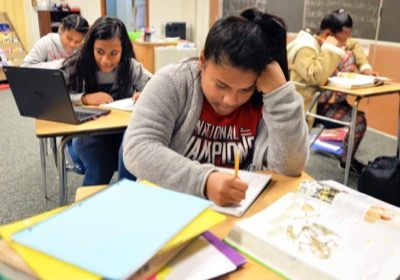Saturday, October 20th, 2018
Schools can use e-learning to cut need for make-up days
By Sydney Albert

Photo by Dan Melograna/The Daily Standard
E-learning days have become a useful tool for educators, such as those in Celina City Schools, to ensure students attain the state-required classroom hours. An example is seen here as Irene Lometo works on an assignment with her textbook as Magedlin Hiram uses a Chromebook on Friday at Celina Middle School.
CELINA - Snow days and school cancellations may be fun for kids at first, but they become less so when make-up days cut into their summer vacations.
With many schools offering students more access to technology, e-learning days are one option schools and students can use to make up for lost time in the classrooms.
The Ohio Department of Education requires that schools be open for a certain number of hours each year, but it also advises they schedule "excess" hours into the year to accommodate for possible delays and cancellations. The number of excess hours can be approved at district officials' discretion, but even accounting for those factors, officials can still need to make up for lost time when poor weather, law enforcement emergencies or other incidents rack up over the year.
Celina City Schools Superintendent Ken Schmiesing said the school board has approved e-learning days every year since he's been superintendent. The district accounts for up to five "calamity days," time lost due to delays or cancellations, but if the district uses up those days, officials can implement e-learning.
When district officials held an e-learning day last year, they notified parents over the phone. Older students received work to complete online, while younger ones were given "blizzard bags" with assignments on the next school day.
"I feel it went smoothly, because so much of the world is more technological now," Schmiesing said.
The district's 1:1 program gives older students access to Chromebooks, meaning families don't need a home computer or device of their own for students' use. Some students may not have access to reliable internet at home, but any work assigned on e-learning days isn't due until two weeks later, he said. That gives students time to access Wi-Fi at another location such as a library or once school is back in session.
Fort Recovery superintendent Justin Firks said the school board approved E-Learning days prior to his being hired, but the district hasn't needed to use one since he's come on board due to mild winters.
Officials have worked with kids to meet deadlines and tried to make sure teachers were available via email during the day to help with assignment questions, Firks said.
Like Celina, Fort Recovery's 1:1 program gives high schoolers home access to Chromebooks, but Firks noted that teachers take into account when students didn't have internet access.
The lower grades were given "blizzard bags." You couldn't expect a kindergartner to participate in e-learning days, Firks said, as it would put more pressure on parents to be present to help their children navigate online work.
According to Firks, a follow-up survey asking for thoughts on the e-learning day had shown mixed reviews.
Many other area educators chose not to participate in e-learning days or haven't put policies in place addressing them. Several give out blizzard bags with hardcopy assignments for students at every grade level if time needs to be made up.
Why educators choose not to use e-learning can vary. Some districts, such as Parkway Local Schools, don't have 1:1 programs that would facilitate e-learning. Others, like Coldwater Exempted Village Schools, simply choose to make up lost days in the more traditional way.




